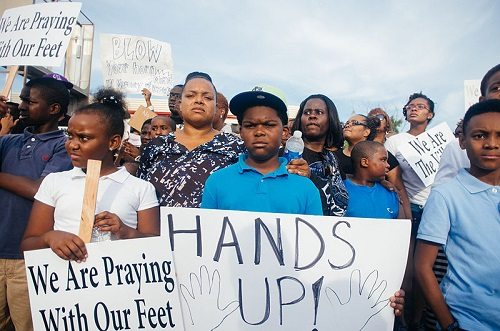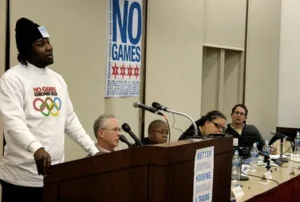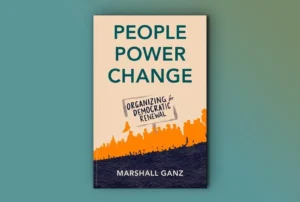
As the events of Ferguson fade from the headlines, replaced by the crisis in the Middle East and elsewhere, foundations and nonprofits are grappling with what they ought to have done in response to the killing of an unarmed black teenager in the streets of this small suburb of St. Louis. The answers are hardly simple and discrete.
In this commentary, we suggest that foundations need to pay significantly more attention to the problems of inner-ring suburbs, which may be the new—and in some ways harder to address—venues of America’s socio-economic and racial inequities. But foundations must also get serious about grantmaking that addresses persistent and pernicious issues of race, and this requires more attention to and support of “gritty” community organizing. Without grantmaking support that matches foundation rhetoric about attention to race, it is too much talk and too little action.
The Mythology of Previous Fergusons
It must have surprised many Cincinnatians to discover that the Queen City’s recovery from its riots in 2001, the aftermath that followed a police killing of an unarmed black man, has been resurrected as an example for Ferguson and other localities to emulate. In Cincinnati today, there are new programs that address policing in minority communities.
What these revised histories fail generally to note is that no indigenous revelation found in the streets of Cincinnati led to changes in community-police relations. Rather, it was deep and consistent organizing led by community leaders such as Rev. Damon Lynch, who refused to back down despite significant hostility from city leaders. When black leaders announced an economic boycott of Cincinnati, the then-mayor, Charles Luken, called it “economic terrorism.” The community was using a tool at their disposal to deal with a city whose police force had killed 15 black men in five years. The response, which this author remembers quite well from having been brought into Cincinnati by a national nonprofit intermediary, was the attitude of some community leaders to defund the nonprofits and activists associated with the protests.
Lynch came to Ferguson to distribute information on the agreements that he and other activists hammered out with city officials at the time, but he was candid about what it took to get there and what it might take in Ferguson. He reminded people in Ferguson that a “soft, get-along approach” wouldn’t work, that tools such as boycotts should be considered, and federal intervention might be necessary. Calling in the federal government in Cincinnati was important leverage activists were able to deploy against recalcitrant government and community leaders. The solution was not simply to hug it out, but in the haze of history, that’s how some in the press and the public like to imagine the solution to racial tensions as having been.
What Lynch demonstrated in Cincinnati is that answers are rooted in gritty community organizing and community mobilization. How else to explain Ferguson, where a two-thirds black city is governed by almost totally white governing bodies? Community organizing that should have gotten the black electorate to the polls clearly didn’t exist, leading to a black voter turnout of roughly seven percent in the 2013 municipal elections, less than half of the not-much-less-unimpressive turnout of white voters.
The Challenge of Inner-ring Suburbs
Although they date back to before the Great Depression, inner-ring suburbs like Ferguson saw much of their major growth after World War II. Americans left inner city neighborhoods looking for a better life in the suburbs, abetted by FHA financing for home purchases and the development of interstate highways.
In many metropolitan areas nowadays, these inner-ring suburbs are small cities that exhibit many of the same problems as inner city neighborhoods, particularly a sharp increase in poverty and, in recent years, a particularly significant dynamic of home mortgage foreclosures. Once highly sought after “streetcar suburbs” like Chelsea outside of Boston, Cleveland Heights outside of Cleveland, and District Heights and Seat Pleasant outside of Washington, D.C. evince problems of inner city–like socio-economic challenges. In many such troubled inner-ring suburbs, the demographics have become increasingly dominated by persons of color—like the two-thirds black suburb of Ferguson.
Ferguson is just one small suburb among scads of suburban municipalities in St. Louis County. Ferguson’s current racial tensions regarding policing follow prior examples in the county, including the town of Jennings, where the problems of racism in the police force were so severe that the police force of Jennings was shut down. Darren Wilson, the Ferguson policeman who shot and killed Michael Brown, was a cop in Jennings at the time that the department was declared corrupt and racist. Ferguson’s overwhelmingly white police force has not been shuttered, but the history of its disparate treatment of blacks with being cited or arrested has been well documented and could constitute a case for disbanding the Ferguson operation as no less racist.
The reality of places like Ferguson is that they are far from the refuges that post-World War II Americans sought as their step up from inner-city life. Rather, as put by Pete Saunders, writing for the Guardian, Ferguson is an example of the “‘resegregation’ of America’s once-aspirational inner suburbs which—far from the social utopias they were meant to be—have become ethnic enclaves: white in one pocket, black in another.”
The inner-ring suburbs are problematic not just because of policing, but because they now reflect the dimensions of racial disparities in education, employment, and income that characterize big cities. For example, in Ferguson, household income of whites is $52,000, compared to $30,000 for blacks. “The story of Ferguson,” Saunders writes, “is truly a tale of two suburbs.” Indiana University researcher calls places like Ferguson “ethnoburbs.”
This dynamic shows up in other parts of the nation as well. For example, at the height of the foreclosure crisis, four inner-ring suburbs of Cleveland had higher rates of foreclosure than Cleveland itself, in part because subprime mortgages were particularly prevalent among minority homeowners, such as the black families that sought homeownership opportunities in the suburbs, and partly because banks could make more money by foreclosing on and reselling homes in the suburbs than they could on homes in troubled inner-city neighborhoods.
Many inner-ring suburbs have revived patterns of segregation, including, according to Saunders, “south Cook County outside of Chicago; Prince George’s County near Washington, DC; parts of Delaware County adjacent to Philadelphia; eastern Cuyahoga County near Cleveland; parts of DeKalb County outside of Atlanta; and parts of North St. Louis County, outside of St. Louis—including good old Ferguson.”
Sign up for our free newsletters
Subscribe to NPQ's newsletters to have our top stories delivered directly to your inbox.
By signing up, you agree to our privacy policy and terms of use, and to receive messages from NPQ and our partners.
The challenge of dealing with the revival of places like Ferguson and dealing with racial disparities there that go far beyond issues of policing is different than the purported solutions that have emerged for inner cities—that is, if one considers the gentrification of the Over-the-Rhine neighborhood of Cincinnati a solution to the problems that led to the riots there a more than a dozen years ago.
Mistaking Police Bias for Deeper Problems
The press coverage of Rev. Lynch’s presence in Ferguson focused on the “Collaborative Agreement” that emerged to change police attitudes in Cincinnati, what some observers refer to as “de-policing”—educating and guiding police to think of themselves more as social workers than, as in Ferguson, militarized troops fighting the enemy. Policing is an obvious and emotional target for action and change, but it is not the root of the problem in inner-ring suburbs. Policing problems like those in Cincinnati and Ferguson can be addressed, but they don’t solve the underlying problems of racial injustice, according to Rich Benjamin, writing for Al Jazeera.
“Structural racism is the deeper disease, and acts of police misconduct are merely a symptom of it. It concerns how we distribute public resources to strengthen or debilitate our communities. Unemployment, underemployment, foreclosure and destitution have become the hallmarks of America’s new multicultural poor, a group that negates conventional political and academic assumptions about aspiration and poverty in America’s suburbs.”
Let’s assume that Office Darren Wilson is eventually indicted and even convicted. That might be warranted as justice for Michael Brown, but it doesn’t address in any way the race-based socio-economic disparities of small inner-ring suburbs like Ferguson. The problems of inner-ring suburbs require much more than ridding their police forces of military tanks and Humvees. In suburban Minneapolis, for example, the inner-ring suburbs of Brooklyn Park and Brooklyn Center have joined with the Metropolitan Interfaith Council on Affordable Housing, charging that the Metropolitan Council and the Minnesota Housing Finance Agency have perpetuated fair-housing violations against minority residents. All too often, public policies are exacerbating racial segregation and hardening socio-economic disparities in the inner-ring suburbs.
Cities, observes urban historian Steven Conn, have shown “a remarkable capacity to regenerate themselves,” but the same isn’t clear at all about inner-ring suburbs like Ferguson. An answer that focuses on demilitarizing the Ferguson police and indicting Officer Wilson is far from the core issues of racially segregated, economically short-changed places like Ferguson. Peter Dreier and Todd Swanstrom predict that Ferguson might be “the first in a wave of suburban riots,” disturbances sparked by “racially tinged police abuse” but rooted in deeper social, economic, and racial problems.
Philanthropy for Inner-ring Suburbs
Dreier and Swanstrom nail the challenge of addressing these issues:
“Like many other poor suburbs, Ferguson is simply too small and too poor to address the underlying racial and economic disparities that are fueling the current protests. It lacks good public transportation to areas with good jobs, isolating it from economic opportunity…. Unlike most big cities, it has few social agencies and private foundations devoted to job training, affordable housing and other programs. It has few hospitals and health clinics. Banks, supermarkets, pharmacies and other retailers either bypass these communities or exploit them with predatory loans, high prices and lousy service. Almost half of Ferguson’s homeowners are ‘underwater’—they are drowning in debt because their homes are worth less than their mortgages.”
In general, small cities in the suburbs, places as small as Ferguson and the other more than 300 units of local government in St. Louis County, simply don’t capture the attention of most foundations. As a result, even in poor inner city neighborhoods where foundations have invested in community development nonprofits that contribute to building social capital, those social capital builders in inner-ring suburbs are often in short supply—and the philanthropic money to sustain them is even shorter.
Foundation activity in inner-ring suburbs is scarce. A study by Sarah Reckhow and Margaret Weir for the Brookings Institution examining philanthropy’s response to suburban poverty suggested that most community foundations in the suburbs are newer and smaller than their big city counterparts and not strongly attentive to building organizational capacity or supporting community organizing. Other kinds of institutional foundations—corporate and independent foundations—have concentrated their efforts in cities, not suburbs and, oddly, provide “fewer grant dollars per poor person than do central cities and suburbs with lower poverty levels.”
Beyond the lack of philanthropic attention to inner-ring suburbs, there is the additional issue of the inadequacy of foundation responses to issues of race. While some foundations have undertaken impressive initiatives, notably such large foundations as the California Endowment and small grantmakers like the Akonadi Foundation, it seems that philanthropy has done better discussing issues of race—institutional racism or structural racism—than it has in making substantial investments aimed at addressing the factors that lead to situations like Ferguson.
Despite a history of racial incidents in this nation in the past 20 years, from South Central through Hurricane Katrina and the shootings of Trayvon Martin and Jordan Davis, philanthropy seems to have generated an ability to talk better about issues of race, but performance overall doesn’t seem to have made commensurate progress. For a piece we wrote on philanthropy and structural racism earlier this year,several foundation executives spoke to us—largely off the record—about the shortcomings of the field.
One retired executive suggested that the impact of all of the attention in the foundation sector had been marginal in terms of funds reaching communities of color. “I don’t see more resources or a more equitable share going to communities of color,” he said. “I don’t see more resources going to organizations or grantees headed by a person of color.” The greater philanthropic consciousness of structural inequities, many said to us, hasn’t been matched by much more overall grantmaking on issues of race, much less grantmaking reaching the kinds of community-based organizations that Lynch worked with in Cincinnati, much less targeting strategies that might be characterized as tackling structural problems rather than addressing symptoms. Another retired executive even questioned the premise of increasing levels of philanthropic attention: “I look at foundations today and I don’t see a lot of consciousness of race,” he observed.
Is there an agenda for foundations in the Fergusons of this nation? If there weren’t, that would be a terrible indictment of the foundation sector. A possible foundation strategy that learns from Ferguson as well as Cincinnati, South Central Los Angeles, and much more, would include the following:
- A serious major foundation commitment to addressing the increasing poverty and racial polarization occurring in inner-ring suburbs like Ferguson commensurate with the poverty and inequities they face
- Support for community organizing initiatives targeted to inner-ring suburbs, including organizing that leads to civic mobilization and civic engagement, such as voter registration and get-out-the-vote initiatives
- Strengthening business connections and commitments to inner-ring suburbs
- Using community foundations as catalysts for community-wide (or even multi-community) planning and strategy development for addressing racial inequities in the inner-ring suburbs
- Support for initiatives that are less rhetorical and more pragmatic, led and staffed by people who know what community policing and other community-based policing initiatives require
- Tackling the problems of housing development, homeownership opportunities, and foreclosure in inner-ring suburbs, a constellation of challenges that without adequate attention leads to community instability and a deprivation of minority communities of a means of building asset wealth
- Stronger infrastructure for community-based nonprofits in the inner-ring suburbs so that the social capital development that occurs in inner city neighborhoods gets matched and replicated in these small suburban communities












